
How often in life does a person or business leave you feeling as though you got the better end of the deal? For example, my Amazon Prime membership of $12.99 a month feels like stealing.
(yes I need that towel rail delivered in 2 days even though I won’t install it for 3 months.)
I’d be more than happy to pay $10 more per month for the service given how much I use it and why I feel I get the better end of the deal. This feeling is them creating a value surplus, the value I’m getting exceeds the price I’m paying.
It also works for them as a business because they have over 150 million Prime members, which makes this possible with the economies of scale.
Unfortunately, this surplus value isn’t the norm.
When was the last time you paid for something and felt cheated?
Here are some common examples:
- Airline change fees
- Baggage fees
- Expensive parking
- ATM Fee’s
- Gym signup fees
(Basically, 99% of the money is spent at an airport)
How did you feel towards the brand, person, or organization when you paid that money?
Chances are you felt instant buyer’s remorse. You may have felt anger or frustration too – especially if you thought the company took advantage of you and you had no other purchasing option. That’s an instant value deficit.
I shared the idea of overdrafting relationships in my article on building a personal network (even if you’re an introvert) and this applies to this scenario as well.
Even if the investment was just $10, the feeling of a negative surplus leaves a poor taste in your mouth.
So how do we do it differently?
Focus on ALWAYS creating a Value Surplus
Much like the way I think about my Amazon Prime membership, you want people to think the same way about you whether it’s you as a human, as an employee, as a company, or even as an employer.
Creating value surplus in a business allows you to keep loyal customers, turn them into brand evangelists, and further grow the company.
As an employee, a value surplus ensures upward mobility and career growth, not to mention higher job satisfaction.
As a manager, you will begin to attract A-players.
As a human, you’ll discover how you can make more impact and feel more fulfilled.
By creating a value surplus you’re always a Return-on-Investment (ROI) positive person, always giving more value than you take.
ROI-positive people and businesses think and act differently.
ROI-positive people intentionally figure out how to create a surplus of value because they know it’s the catalyst for more growth, more opportunities, and a more fulfilling life for them.
Why you MUST create a value surplus
Here are some examples of two similar products on opposite ends of the value surplus spectrum: Cable vs Netflix.
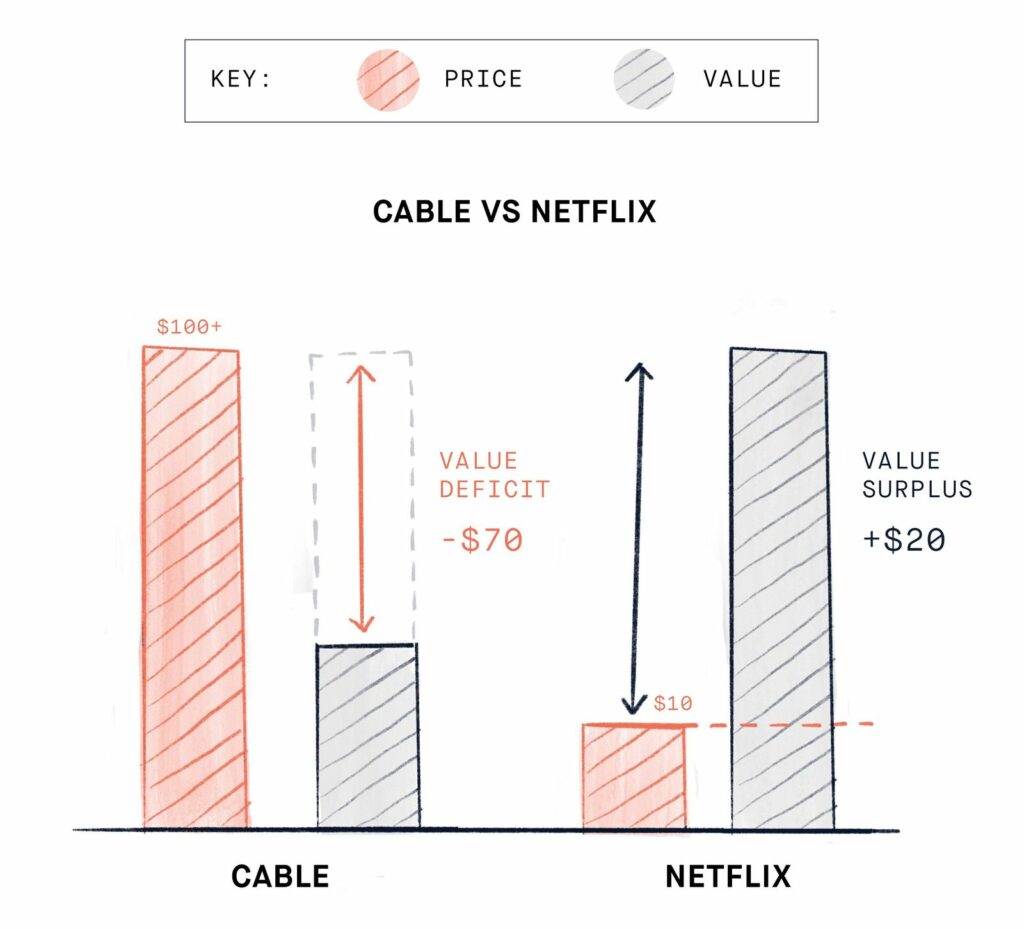
After they add in all the fees, cable to add up to around $100+ a month.
For that price tag, you get:
- A company that’s a pain to deal with
- Hard to cancel (you have to speak to someone on the phone )
- Locked into a contract
- Any issues require a phone call (again )
In fact they’re so frustrating you might turn into a Karen at times just dealing with them…
In this case, not only is there a zero value surplus, there’s a value deficit… which is why I haven’t had cable in 3+ years.
Meanwhile, Netflix puts out content that you can watch on your schedule, on any device at any time. You can cancel easily and it costs a 1/10th of the price. Netflix gives me so much value that I’d happily pay 2-3 times more for the same service.
If I were looking to cut my expenses, every service with a value deficit would be the first to go.
Disclaimer: I’m a millennial, so maybe my value filter is different if you love cable!
Here are other products/services that create a value surplus for me:
- Cheryl (my executive assistant)
- Amazon Prime
- Espresso machine
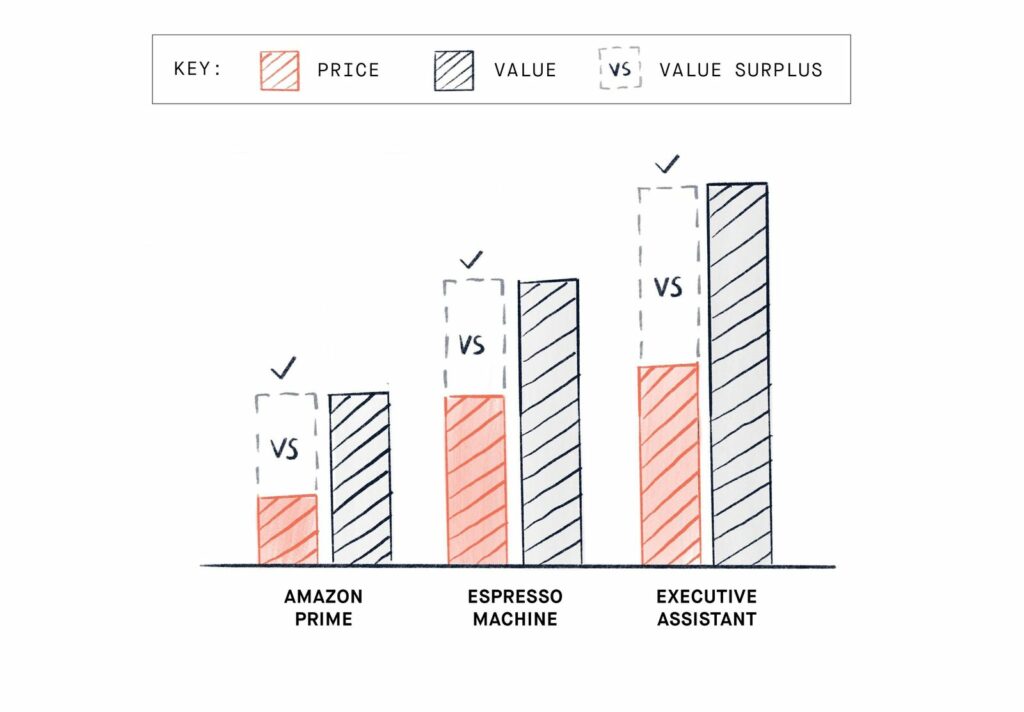
- Amazon Prime is a no-brainer [for me and at least 150 million other people in the US] because of fast, 2-day shipping and on-demand entertainment.
- I use my Espresso machine every single day – at least twice. Before having this gadget at home Emily and I would go out for coffee almost every day, and we liked fancy coffees that cost $4-$5. The espresso machine paid itself off within 60 days and 18 months later I’m still loving it (and saving around $100 a month on take-out coffee).
- It’s not just subscriptions, services, and products that create a value surplus – people are the same.
- Like my assistant, Cheryl. She creates a value surplus by giving me back 20-30 hours per month by handling things like managing my calendar, emails, admin, appointments, and making those pesky calls I hate. With these tasks off my plate, I have more bandwidth to work on bigger creative projects that I might otherwise not have time for.
The dangers of a value deficit
We’ve already explored what a value deficit product/service looks like; the same values principle applies to people.
I met a guy named Bill, he was a perfect example of a scarcity-based employee.
Bill told me he was making $100K a year and had sold $132K of product by the end of Q3. He spoke proudly of himself for this and his attitude showed that he felt like his work was done as he went into Q4. In his mind, he’d created a $32K value surplus as he’d made his company more than he was paid.
Bill was mistaken.
(Disclaimer: I used to be like Bill too, wait and see how…)
Bill was tracking the wrong figures. After payroll taxes, time to onboard, cost of the product, fees, insurance, benefits, and office rent, Bill’s company was likely just breaking even on his output. If Bill continues with this scarcity mindset, with each month's payroll that’s run his check will get harder and harder to justify until he ends up on the chopping block.
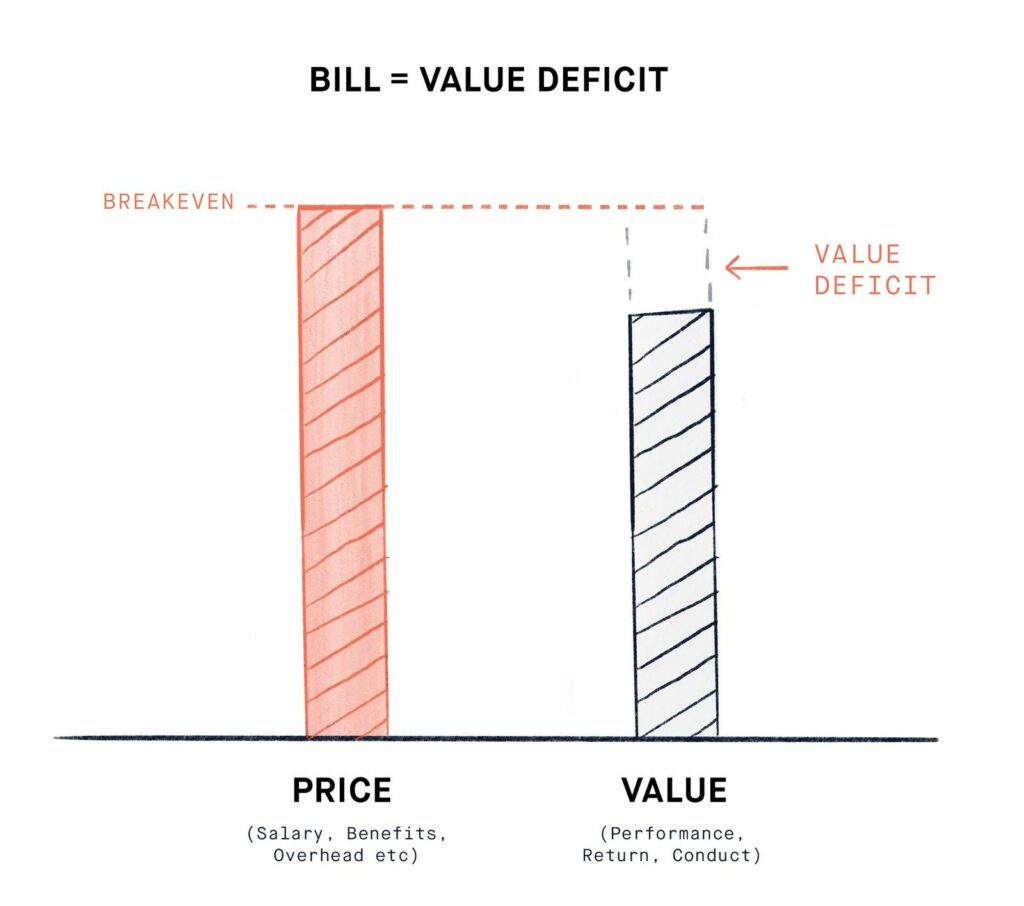
Don’t be like Bill.
Bill won’t survive in this economy.
The way to get ahead at your job is to give your employer a positive ROI. Coasting may be fine in some jobs, but to get ahead, create goodwill first by creating a value surplus.
As an employee, I didn’t always understand this concept – I was definitely a Bill with my numbers. At my last architecture job, I saw the billed hourly rate on invoices and thought “Wow that’s way more than I make”. At least 4X! I did not understand the costs involved in employing me and I didn’t understand the ROI concept.
It was only when the tables turned going from employee to employer did I saw the Bill in myself.
Even if your employer is breaking even on their investment in you, you’re a poor investment. Think about it. How often do you hear the investment types bragging about a 0% return? Never.
I’ve said this to my team: We don’t sell products at cost and we don’t hire people at cost.
If there’s no value surplus, then there’s no growth – and when there’s no growth, you’re essentially on a hamster wheel that won’t ever go anywhere.
Most employers aren’t running a government jobs program. There’s no magic budget provided to create jobs to stimulate the economy without a guaranteed return.
(Sidenote: This does not apply to recent COVID-19 stuff which is seemingly a magical budget )
Jobs only happen if a surplus value exists to fund hires. At BestSelf, a small bootstrapped business with limited resources, it’s my fiduciary responsibility to manage investments to ensure a return. This goes from the products we sell to the people we hire.
When deciding on new products, we run the numbers on the cost to make the product vs the potential return. If the data doesn’t hit our minimum amount, then we don’t move forward.
Typically this should be a 4-5X return and I expect the same with people on the team.
Disclaimer: I don’t mean a direct 5X direct return as we can equate not all roles that way (customer service is a moral example of this) but essentially I’m looking for a 5X value surplus. If I don’t see a surplus of value, it will get more and more difficult to justify your check every month.
As an employee, you don’t want this. You want it to be a simple decision for your employer to keep paying you.
This is how you become recession-proof.
This leads to promotions, pay raises, and career growth.
Note to business owners! If there’s someone on your team you don’t enjoy paying, it’s likely not because you’re cheap (hopefully) — it’s because you’re not seeing a return. This gut feeling is often the result of a lot of thoughts you haven’t yet put into words but is based on something of substance.
Action: You need to put them on notice and set some KPIs. If they do not meet them then you need to free them up, and their salary investment, for other opportunities that will be a better ROI for the company.
How to Create a Value Surplus at Your Company
Now you know what a value surplus is, what are some ways you can create a surplus?
For your employer:
Take absolute ownership. Here’s an excerpt from our Employee Handbook at Best Self, which explains what Absolute Ownership looks like.
Employees: Absolute Ownership – Act like an owner.
One of our core values at Best Self is absolute ownership. Everyone has a stake in the success of the company and should be passionate about opportunities with huge potential wins for the company and the
Always consider what’s good for the company long-term.
What this looks like in action
If we see something that needs doing, we do it! We care about things outside of our job title and department. If it’s good for the company we own it. We speak up if we have an idea. We pitch ideas and give feedback so that we continue improving things! If a task is unclear to you, you ask about the objectives and gather more information. When something feels stale or bloated, you ask yourself whether it needs to be done in this way for a specific reason. We get things done! We don’t wait around for permission, we take the lead and ask the right questions along the way.
When you take Absolute Ownership, you go above and beyond what is strictly in your job role. You take ownership, find problems, and fix them. You look for opportunities and then break down all the steps and resources needed to take advantage.
This approach adds surplus value to your company because your manager or bosses have a million and one opportunities and problems going on simultaneously. Having the team take things off their plates or even better, directly solving problems they didn’t even know existed is AWESOME.
Running a business is like playing whack-a-mole, where there’s a constant barrage of opportunities to seize and problems to solve at all times. Then as soon as one has been solved, another 2-3 appear. It’s like this (that’s my hammer):
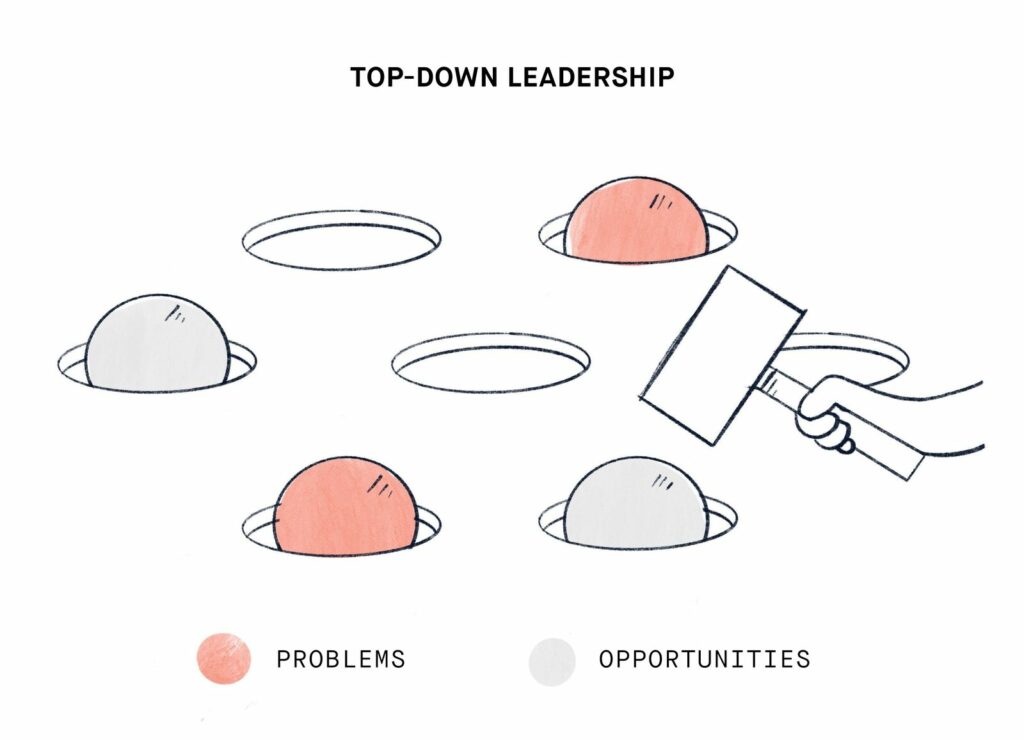
In a company where the team acts like owners, it can look like this:
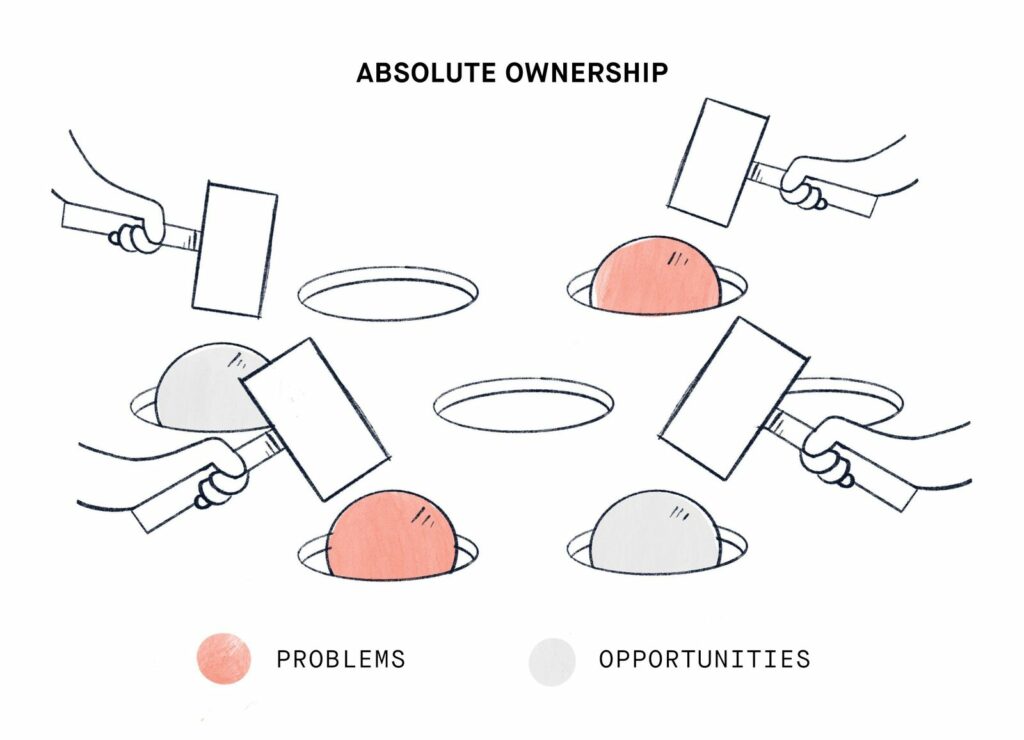
Here’s a real-life example of absolute ownership from my employee days:
At my last architecture firm, we were pushing a deadline for a big competition and there were just three days left. I had taken the lead on gathering everything for the final presentation (even though it was never officially given to me).
We were still designing and putting assets together and realized we also needed some 3D renders that would take at least 48 – 72 hours to create. Given the time crunch, it would be next to impossible to render these given we had less than three days to go.
Rather than go to my bosses and tell them my concerns, I took 10 minutes to Google some possible solutions. I discovered a render farm that could do what we needed quickly and for less than $50. Then I went to my bosses with the problem and the solution I thought would work.
They approved.
We ended up getting everything completed on time and the presentation went great. My bosses took me to get a coffee after the presentation and brought up how they had appreciated that I had not only spotted a potential problem but that I had come to them with a solution and action steps to make it happen.
I made their decision easy and freed up their bandwidth.
This is a small example. At the time I didn’t think it was a big deal. However, now as I hire and lead people, I LOVE it when someone comes to me with a problem solved or merely needs approval on taking an action they’ve already mapped out.
Here are some other questions you can ask to demonstrate Absolute Ownership in your work:
- How can I make more money for the company?
- How can I save money for the company?
- How can I make something more efficient to save people time so that they can focus on 1 or 2?
Here are some examples of these in action at BestSelf:
Saving money:
- Audit Shopify apps to ensure we’re not paying for something we no longer use. We saved $7,000 a year with this simple but effective activity.
Saving time & money:
- Switching from Sketch to Figma for designs to save time for non-mac users who can’t use Sketch. Saved time and $$$ as with Figma in use we could cancel Invision and Sketch.
Opportunity to make money:
- Looking for opportunities: Monthly outreach to potential partners for collaboration
- Create a Folder for the team to share great ads that they see online for inspiration for the media team
For your customers:
As we’ve already explored, you create a value surplus for your customers if they feel they’re getting more than they are paying for (like the Netflix example mentioned above).
Create a Surplus Value and customers are likely to become repeat customers – or if they’re already on a subscription, they’ll likely keep paying. In turn, you’ll benefit your bottom line through a lower churn rate plus you’ll need fewer new customers to maintain and grow your company.
My friend Nathan Barry talks about creating value with SaaS products in this blog.
As a reminder, you want your customers to feel about you the way I feel about my espresso machine. Achieve this, and you’ll attract fewer cancellations and returns and more referrals [because people love to share when they feel like they’re getting a good deal]. In turn, you also get faster organic growth and more repeat customers.
You can create a surplus value through:
– Excellent customer service: Zappos
– Great product experience: Apple
– Success with the product (i.e. their purchase solves their problem): Shopify
With those angles taken care of, you can get creative.
For your employees
If you want to build an A-player team by hiring and keeping great people, you must create a value surplus for them. You don’t want a positive ROI team asset walking out the door to a better offer.
If two places are paying the same, ask yourself what else you can do to increase the value for employees so they choose to work with you rather than someone else.
Here are some ways you can increase value as an employer:
- Company culture & mission
- Ability to work remotely
- Extra vacation time
- Autonomy in their role
- Conference or continuing education budget
- Equipment budget
- Benefits (Health, vision, dental etc.)
- Growth and progression opportunities
- Profit sharing
- Equity / Options
- Community Impact
In your personal life
We’ve spoken a lot about creating a value surplus at work, but the same principles apply to the quality of your relationships too. If you consciously create a value surplus with those you care about most, you can deepen your relationships and strengthen your connections.
Here are some ways you can be intentional with your time and relationships outside of work –
- Start building your network so you can be the person who creates value through creating connections. I share more about what I did it here >> How to build a world-class personal network (even if you’re an introvert)
- Discover your partner/friend’s Love Language: Then make it a point to do something to show them you care regularly. I even have new hires complete the Love Languages test so that the rest of the team and I can better understand them.
- Create touch points to let people know you’re thinking about them
- If you read an article that you feel would benefit or help someone you know, send it to them with a personal note.
In closing…
While the creation of surplus value takes work, it’s never a waste. Once you become a positive ROI person, you’ll give yourself an unfair advantage, because other people or companies won’t be able to compete with you.
Surplus value is the extra mile, but it’s worth going there.
Because the extra mile is never crowded.
I save my best stuff for my emails. No spam ever.
